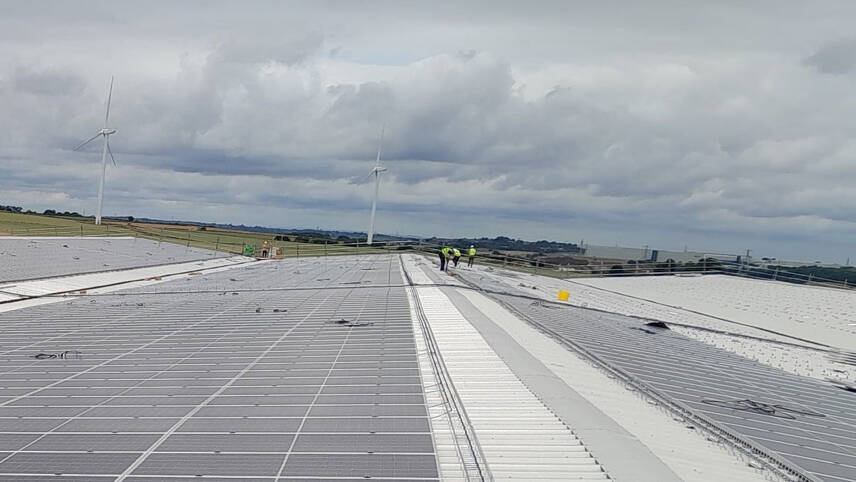Register for free and continue reading
Join our growing army of changemakers and get unlimited access to our premium content

Image: Mawdsleys. Pictured: Rooftop solar on a pharma warehouse in Doncaster, England
edie’s recent survey of 225 UK-based energy managers and sustainability professionals revealed that 70% see transitioning to net-zero as either a high priority or business-critical priority this year. Despite financial challenges, most are looking to revamp their organisation’s approach to energy.
As one of the fastest-growing sources of renewable energy, onsite solar represents a key enabler for businesses to slash emissions, cut costs and boost resilience. But the rollout of such projects is not without its challenges – whether it be grid constraints, site requirements or changing policy and legislation.
With that in mind, edie partnered with Wattstor to host an online masterclass event cutting through the complexities relating to onsite solar – plus related battery storage and energy management systems.
This masterclass originally aired on Tuesday 10 October and a recording is now available on-demand. In addition, this article summarises three of the key steps our expert speakers recommend that organisations interested in onsite solar follow.
Click here to stream the recorded webinar on-demand.
1) Consider the key potential benefits of onsite solar to your organisation
Wattstor’s chief commercial officer Kevin Ball kicked off the masterclass with an explainer of business’s primary motivations for investing in onsite solar, which has been an option in the UK for just over a decade.
He noted how the upfront cost of solar panels has fallen sharply in that time, making them an ever-more attractive proposition. Most businesses, he said, choose to install them to improve their energy resilience, decrease their energy bills and reduce their Scope 2 (power-related) emissions.
This latter factor has become increasingly high of a priority since the UK Government legislated for net-zero by 2050 in 2019, compelling many businesses to think in more depth about their own decarbonisation journeys.
“it’s a matter of when – not if – your customers are going to be looking through their value chain and demanding net-zero of their suppliers,” Kevin said.
Many businesses are now opting for electric transport and heating options to reduce their emissions and this makes the business case for solar even stronger.
Kevin explained: “This inexorable trend of electrification is really gathering pace and happening in rapid time… I’ve never seen it happen so fast as it has in the last three or four years.”
Another key driver could be grid bottlenecks. For example, service stations, car parks, shopping facilities and all manner of other facilities may want to offer vehicle charging but may face a wait exceeding seven years to increase their connection to the grid.
2) Look closely at your energy requirements
Kevin explained that, in general, organisations with higher annual electricity demands will be better suited for onsite solar. Wattstor is particularly seeking clients with annual power consumption exceeding 1GWh.
Nonetheless, it was noted that onsite solar options are available all the way down to residential-scale systems for an individual home, which still benefit from good payback periods.
One of Wattstor’s clients is pharmaceutical wholesaler and distributor Mawdsleys. The firm’s chairman Harry Westall was on the webinar to outline how he had built the business case for a large solar and battery energy storage array at its warehouse in Doncaster.
He recommended that, as well as considering total electricity demands for the site, organisations should consider how the electricity is used. The Mawdsley’s warehouse, for example, is temperature-controlled. Electric vehicle (EV) charging is a key consideration as well as heating, cooling and lighting.
In time, Mawdsleys hopes to use its solar array to charge electric HGVs. It also hopes to replicate the model at Doncaster in other locations.
3) Assess whether you need energy storage
When the electricity is used is another major consideration.
Solar generation will need to be co-located with a battery if organisations want to use more energy overnight or simply to “avoid peaks and capture troughs” relating to energy prices and grid demand, Kevin explained.
He said: “The last thing your electricity supplier wants is for you to install a large PV project on your roof and then randomly spill that electricity onto the network just at those times when it is least wanted. The midday price dip… is predicted to get even worse and be even steeper [next] summer.”
Another potential solution is partnering with other organisations to create a solar microgrid. This could be a particularly lucrative option for sites with a lot of space and multiple electricity users, such as retail parks, shopping centres and business parks.
“Traditionally, if the landlord developed the roof of a building, most of that energy would be sold to the grid. This doesn’t really help the tenants reduce their own metered consumption,” Kevin explained.
The typical alternative involve splitting solar arrays by tenant but this is not optimal in terms of balancing generation and demand. A microgrid can help overcome this.
Mawdsleys’ Harry did note that building the business case for a battery to the board is currently more complex than crunching the numbers on solar. But he added: “The payback time for just solar is the best, but it does not really account for the holistic, site-wide approach.”
He noted that solar and batteries have “very predictable outgoings”, which made them attractive to the board amid the ongoing energy price crisis.
Click here to stream a full recording of the webinar on-demand.


Please login or Register to leave a comment.